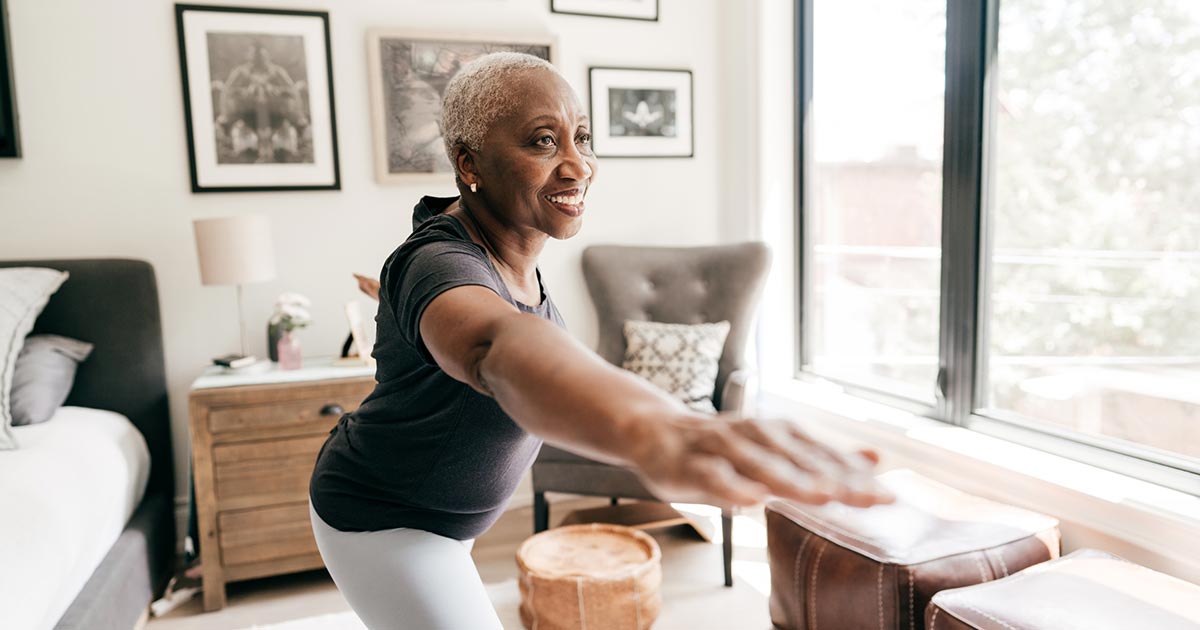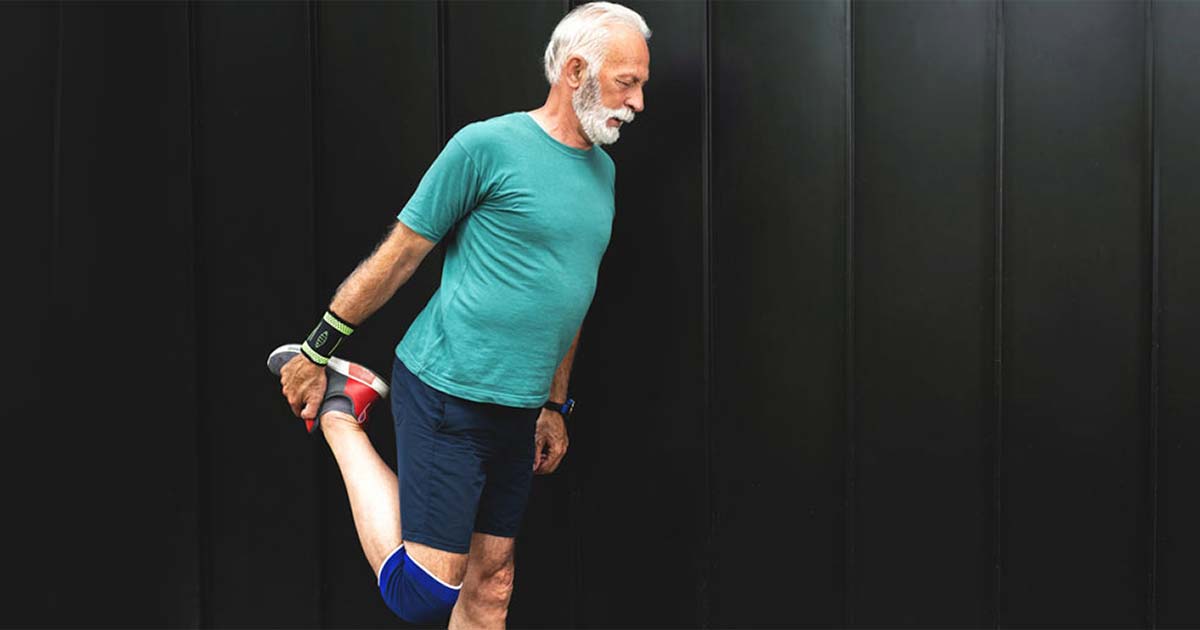
Advice to improve your movement, fitness, and overall health from the #1 in orthopedics in the U.S.
Is Yoga Safe to Do After Joint Replacement Surgery?
With the green light from your surgeon and some adaptations for your new joint, yoga can have great benefits for people recovering from a joint replacement.
Advice to improve your movement, fitness, and overall health from the #1 in orthopedics in the U.S.

“Yoga may help you become more aware of your body, including your muscles and joints,” says Christine Mironenko, NP, who works with patients after surgery and has practiced vinyasa yoga for 15 years. “Yoga may help with flexibility and overall posture, strengthen the muscles around your new joint, provide pain relief and even improve digestion.”
Yoga’s relaxation benefits can also be a big help—after all, joint replacement is a major surgery. The stress of the surgery itself as well as the pain you may feel leading up to it can take a toll. “Many patients are not prepared for the mental stresses their recovery might entail,” says Mironenko. “Yoga can help with stress relief, as well as insomnia and postoperative pain.” Before starting yoga, you must first get medical clearance from your orthopedic surgeon. “Most surgeons recommend waiting anywhere from three months to one year, again taking into account your medical history, type of surgery and other factors,” she adds. Your doctor will also give you any specific precautions to take.
Your new knee, hip or shoulder will often have limitations. Modifications will be necessary for a safe yoga practice. “A prosthetic joint implant is designed to perform activities of daily living and is not exactly made for advanced yoga poses,” Mironenko says. “In addition, the stress of the surgery on surrounding tissues may make them more vulnerable to injury or instability. We recommend staying within a certain range of motion and always avoiding any position that causes pain.”
Here are a few other tips for practicing yoga safely after a joint replacement:
- Develop a safe yoga plan with your surgeon. When discussing yoga clearance precautions with your surgeon, it may be helpful to provide photos of the poses to your surgeon. Just talking about poses can be tricky.
- Find an experienced yoga instructor. Ask around and get references from friends and family. Find out from your local yoga studio if they would recommend a certain teacher with experience and knowledge of anatomy. You may notice an instructor helping other students with modifications and asking about injuries before class. This is a good sign. Your teacher should make you feel comfortable and be approachable enough for you to ask questions.
- Always let your yoga instructor know that you have had a joint replacement before starting a class. They can help you correct your alignment to stay safe and provide help with props. Some instructors offer hands-on assistance, and they will need to know not to push you into certain poses, as this could cause injury.
- Never assume that the teacher is knowledgeable about joint replacement surgery. Before you start your yoga practice, you should know your own limits and the precautions you need to take. Never force yourself into a pose or allow a teacher to do so. Do not do anything that’s painful or feels wrong. Listen to your body’s cues to maintain proper alignment and protect your joint replacement.
- Start slow. Immediately after surgery, upper body chair yoga poses are a safe option to stretch and strengthen the arms after a hip or knee replacement. Early on in recovery, a restorative yoga class may be beneficial. Restorative yoga classes are typically slow and gentle, use a lot of props and focus on relaxation. Restorative poses with props would be a great option for total shoulder replacement patients to get into a relaxing pose for some rest. Once you receive the go-ahead from your surgeon, any style of yoga, including Vinyasa or Bikram yoga, is possible as long as the proper modifications are made to your practice.
Yoga after Hip Replacement Surgery
“A few orthopedic surgeons at HSS advise their patients to avoid yoga following hip replacement due to the risk of hip dislocation,” says Mironenko. “Of course, you should always follow the advice of your physician.” Certain medical conditions can increase your risk for this, and there’s often no warning that a hip is about to dislocate, which makes it impossible to use pain or discomfort alone as a guide, she adds.
Once the soft tissues around the hip fully heal, many hip replacement patients get the green light to do yoga. Turning the hips too far in (internal rotation) or out (external rotation) should be avoided to decrease any risk. Extending your leg too far forward or backward should also be avoided, Mironenko says. Again, talking about yoga poses and rotation directions with your surgeon may be tricky, so reviewing photos of poses on your phone can make it more clear.
“Dislocations are rare and usually very patient-specific, but I strongly recommend that people avoid extreme actions of the hip in all directions,” she says. “I even recommend modifications in child’s pose, or Balasana pose. Keeping the knees apart and supporting yourself with a bolster decreases hip flexion and internal rotation.” An experienced yoga teacher can help you with modifications.
Yoga after Knee Replacement Surgery
“Modifications to one’s yoga practice following a knee replacement are a bit simpler,” Mironenko says. “Some patients are not comfortable kneeling, so blankets, padding, or even knee pads can be used to ease discomfort in poses where the knee is on the ground. Also be mindful not to hyperextend the knees,” locking them out straight. Consciously keep a slight bend in the knee, just enough to keep it unlocked, while in standing poses.
“You will also want to avoid poses that put a lot of pressure on the inside or outside of the knee, especially in combination with the added force of pressing your body down when in these positions,” she adds. “Certain positions such as half pigeon pose might stretch the ligaments on the sides of the knees and, over time, could make your knee unstable. These poses can be avoided or modified with props.” How much you’re able to comfortably move your knee during physical therapy is a good guide for what yoga poses are safe to try.
Yoga after Shoulder Replacement Surgery
The muscles surrounding the shoulder are at the highest risk of damage following shoulder replacement surgery. You should wait until the muscle is completely healed before starting any exercise routine—typically 10 to 12 weeks. Work with your surgeon to develop a safe yoga plan.
Yoga after total shoulder replacement can help to stretch and strengthen the shoulder muscles to maximize the benefits of your surgery. “The type of shoulder replacement—anatomic versus reverse—will determine which positions your shoulder and arm can safely move into,” says Mironenko. “Although dislocation is very uncommon, any extreme positions after a shoulder replacement should be avoided. This especially includes extreme internal rotation, like in reverse prayer pose, or Pashchima Namaskarasana.”
A Note on Use of Yoga Props
Whether practicing yoga after knee, hip or shoulder replacement, props are your friend, says Mironenko. “Yoga props, specifically yoga blankets, bolsters, blocks and straps, are used by even advanced practitioners for support or to enhance the benefits of a pose. Yoga is not about how the poses look—it’s really about how they feel. Almost every pose has modifications to make it accessible to everyone, activating the same muscles to achieve the same benefits. Work with your yoga instructor and your surgeon to make a pose work for you. Everyone’s yoga practice will look different because our bodies are unique.”
Published 7/29/2021


